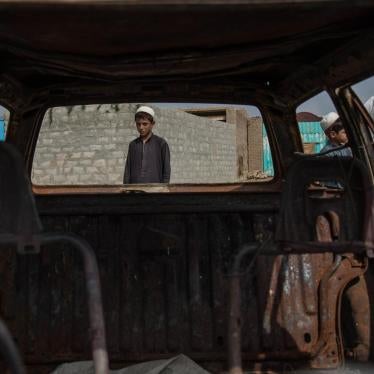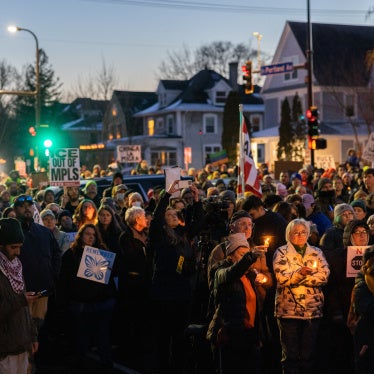The Honorable Barack Obama
President of the United States
White House
1600 Pennsylvania Ave., N.W.
Washington, D.C. 20500
Re: Shared Concerns Regarding U.S. Drone Strikes and Targeted Killings
Dear President Obama,
The undersigned human rights and civil rights groups write to convey a statement of shared concerns regarding U.S. targeted killing policy. Our statement, attached, urges the administration to take essential steps to: publicly disclose key targeted killing standards and criteria; ensure that U.S. lethal force operations abroad comply with international law; enable meaningful congressional oversight and judicial review; and ensure effective investigations, tracking and response to civilian harm.
Sincerely,
American Civil Liberties Union
Amnesty International
Center for Human Rights & Global Justice, NYU School of Law
Center for Civilians in Conflict
Center for Constitutional Rights
Global Justice Clinic, NYU School of Law
Human Rights First
Human Rights Institute, Columbia Law School
Human Rights Watch
Open Society Foundations
--------
STATEMENT OF SHARED CONCERNS REGARDING U.S. DRONE STRIKES AND TARGETED KILLINGS
The undersigned human rights and civil rights groups urge the United States to take essential steps to ensure meaningful transparency and legal compliance with regard to U.S. targeted killing policies and practices, particularly those outside the internationally-recognized armed conflict in Afghanistan. In particular, we call on the administration to: publicly disclose key targeted killing standards and criteria; ensure that U.S. lethal force operations abroad comply with international law; enable meaningful congressional oversight and judicial review; and ensure effective investigations, tracking and response to civilian harm.[1]
I. Disclose Legal Standards & Criteria
Commitment to the rule of law requires that the administration disclose the legal constraints on its lethal targeting operations. Greater disclosure of legal and policy standards, and procedural mechanisms, is a necessary prerequisite to informed assessment and debate by the U.S. public, policymakers charged with conducting oversight, and the international community.
President Obama acknowledged the need to lift the veil of secrecy on targeted killings in his most recent State of the Union address, during which he pledged to ensure that U.S. lethal targeting practices are made “more transparent to the American people and to the world.”[2] We urge the U.S. government to make good on the President’s stated commitment to greater transparency on this crucial issue. Refusal to clarify U.S. legal and policy standards will leave the administration vulnerable to challenges to the sincerity of its commitment to transparency and the rule of law.
We are confident it is possible to improve transparency without putting intelligence sources at risk or endangering genuine national security interests. In fact, improved transparency may serve national security by demonstrating the legal bases for targeted killing policies and practices.
In particular, we urge the administration to:
- Release to the public all Department of Justice, Central Intelligence Agency and Department of Defense memoranda that reflect the administration’s interpretation of operative law and policy concerning the lethal targeting of any person;
- Release to the public the counterterrorism manual reported to exist by the Washington Poston January 19, 2013 (with minimal redactions to protect legitimately secret information);[3] and
- Disclose the legal criteria for identification of targets, including for placement on so-called “kill lists” and for subsequent targeting, and criteria for so-called “personality strikes,” “signature strikes” or Terrorist Attack Disruption Strikes (TADS).
II. Ensure Effective Congressional Oversight
All relevant committees, including the Armed Services, Foreign Relations and Foreign Affairs, Intelligence and Judiciary Committees, should be able to engage in meaningful oversight, and the administration should work cooperatively with these committees. To that end, the administration should provide all members of Congress access to past and future legal opinions and interpretations regarding targeting operations by the CIA and Joint Special Operations Command (JSOC). Moreover, the administration should answer requests by members of Congress for basic information that is a precursor to effective oversight. This would include, for example, Senator Wyden’s request for the names of all of the countries where the intelligence community has “used its lethal authorities.”[4]
III. Do Not Block Judicial Review
Judicial review is a central pillar of checks and balances. It is essential for accountability and transparency. Yet, the administration’s position is that judicial review is “not appropriate”[5] in targeted killings cases and it has invoked broad interpretations of the political question and immunity doctrines, Bivens special factors, and the state secrets privilege to obstruct litigation.
We do not believe that accountability and transparency will be improved by recent proposals to establish a FISA-like court to sanction lethal targeting operations.[6] On the contrary, a special targeted killing court would give a veneer of judicial review to decisions to launch lethal strikes without offering a meaningful check on executive power. Instead, we urge the administration to cease making broad claims of non-justiciability or political question, to prevent cases alleging human rights or constitutional violations from being heard on their merits.
IV. Track & Respond to Civilian Harm
At his recent nomination hearing to be director of the CIA, John Brennan stated that the United States should publicly acknowledge mistaken killings of individuals or groups of individuals, in the interest of transparency.[7] He later said that the administration should “make public the overall numbers of civilian deaths resulting from U.S. strikes targeting al-Qa’ida.”[8] We agree and believe this disclosure is an essential first step toward ensuring accountability and redress.
At the same time, John Brennan and other senior administration officials have repeatedly said that civilian casualties from targeting operations outside of Afghanistan, and particularly from drone strikes, are “exceedingly rare.”[9] Senator Dianne Feinstein has said that civilian casualties are in the “single digits” each year.[10] We are concerned about the factual basis for these claims in light of prima facie evidence and numerous credible reports that civilian casualties have been significantly higher than “single digits” each year.[11] In the context of drone strikes, remote operation makes battle damage assessments and proper post-strike investigations difficult, and the administration has provided no evidence that it can properly assess how many civilians were harmed.
Based on a review of a wide range of civilian casualty estimates, we are especially concerned that the administration may be consistently undercounting and overlooking civilian casualties. Moreover, the administration may be employing an overbroad definition of “combatant” or “militant” that would lead it to undercount civilian casualties.[12] These concerns heighten the need to ensure there are effective mechanisms to track and respond to civilian harm. Moreover, in the context of armed conflict, a track record of undercounting civilian casualties may cause the United States to make an inaccurate assessment of the proportionality element of lethal action—itself a violation of the laws of war. (We describe the appropriate legal standards in and outside of armed conflict in Section V infra).
The reported practice of so-called signature strikes, based on observation of certain patterns of behavior and other “signatures,” adds to these concerns. Signature strikes do not appear to require specific knowledge about an individual’s participation in hostilities or an imminent threat.[13] Since their identity is unknown, even during the strike, these targeted individuals may be confused with civilians who cannot be targeted directly as a legal matter.
In an armed conflict, individuals are entitled to a presumption of civilian status, which the practice of signature strikes may effectively deny, leading to direct attacks on civilians and disproportionate civilian casualties, in violation of international humanitarian law. Outside of armed conflict, this concern would be heightened, since presupposing targetability would be even more incompatible with human rights standards. It would also increase the likelihood that the U.S. government systematically underestimates civilian casualties. A refusal to acknowledge civilian harm compounds anger in impacted communities, and denies victims the justice they deserve.
We therefore urge the administration to:
- Publicly describe the existing processes to prevent and mitigate civilian harm from targeting operations (including with drone technology), e.g., civilian protection protocols and training given to drone operators;
- Disclose the criteria used to determine civilian and “militant” or “combatant” status;
- Disclose government counts of deaths and injuries resulting from targeting operations (particularly those outside of Afghanistan) including counts of civilian casualties, deaths of “operational leaders” or “high-value targets,” and deaths of individuals categorized as “militants” or “combatants”;
- Disclose what “signatures” are considered sufficient to authorize a strike and in what circumstances;
- Clarify and disclose standards for post-strike procedures to investigate the legality of strikes and credible reports of civilian harm, and ensure they do not presumptively categorize individuals killed or injured as “militants” or combatants;
- Ensure that mechanisms for civilian victims or their families to obtain redress, including recognition of harm and compensation or amends, are practically available and effective.
V. Ensure Compliance with International Law
Senior officials have claimed that the administration applies international humanitarian law to its targeted killing program.[14] However, unlike international human rights law, the circumstances under which international humanitarian law applies are narrow and exceptional. There must be an armed conflict: hostilities must be between the United Statesanda group that is sufficiently organized and must reach a level of intensity that is distinct from sporadic acts of violence.[15] Outside of an armed conflict, where international human rights law applies, the United States can only target an individual if he poses an imminent threat to life and lethal force is the last resort.[16] A key preliminary issue is thus whether or not the United States is using lethal force as part of hostilities in an armed conflict.
Even when the United States uses force as part of hostilities in an armed conflict, there are important legal constraints on its targeting operations. The administration’s statements have raised fundamental concerns about whether it recognizes these constraints and complies with international law. We describe three of these concerns below, although they are not exhaustive. The first two involve concerns pertaining to how the U.S. chooses particular targets; the third involves concerns pertaining to the legality of U.S. use of force in other states.
A. The administration’s criteria for determining that it can lawfully engage in lethal targeting of a particular individual or groups of individuals.
The administration should ensure that its standards and criteria for determining that it can directly target a particular individual using lethal force are consistent with international law. It should also disclose those standards so that Congress, the public, and other nations can assess them. Because of the impact that U.S. policy will have on global standard setting on the use of drones in targeted killings, it is critically important that U.S. legal standards be fully disclosed.
There are troubling indications that the U.S. regards an individual’s affiliation with a group as making him or her lawfully subject to direct attack.[17] This raises serious questions about whether the U.S. is operating in accordance with international law. Under international humanitarian law, applicable in the narrow and exceptional circumstance of armed conflict, the U.S. can directly target only members of the armed forces of an enemy, military objectives, or civilians directly participating in hostilities.[18] U.S. standards should reflect a presumption that unidentified individuals are civilians with protection from direct attack, unless and for such time as they take a direct part in hostilities.[19]
Outside of an armed conflict, where international human rights law applies, any use of force must be both necessary and proportionate. Intentional lethal force may only be used where strictly necessary to prevent an imminent threat to life.[20] To assess “imminence” under human rights law and in the context of determining how force can be used outside an armed conflict, the U.S. should look only to human rights law sources. Some administration statements imply that the U.S. government may be attempting to borrow interpretations of “imminence” from the law regarding resort to the use of force (jus ad bellum), which involves a wholly separate inquiry into whether a state can lawfully use force in violation of another state’s sovereignty, to defend itself against an imminent threat (see Section V.C infra).
B. The administration’s criteria for determining that a group is an “associated force” of Al Qaeda, and the implications of that determination.
The administration has stated that it is in an armed conflict with Al Qaeda and “associated forces,” which it defines as organized armed groups that have “entered the fight alongside al Qaeda” and are “co-belligerent[s] with al Qaeda in hostilities against the United States or its coalition partners.”[21] The administration’s failure to define what specific organizational features or conduct would lead a group to be classified as an associated force raises concerns that this results in an aggressive and indefinitely expansive scope of targeting authority.
The administration should disclose the groups it believes to currently constitute associated forces and the criteria for determining whether a group is an associated force. It should set forth the legal basis for considering the United States to be at war with “associated forces” of Al Qaeda that did not participate in the September 11, 2001 terrorist attacks. Moreover, it should clarify who it believes is lawfully targetable with lethal force within such “associated forces.”
C. The administration’s concept of imminence, in justifying its resort to the use of force in self-defense.
Some of the undersigned groups are concerned that the administration’s statements appear improperly to conflate the question of sovereignty with the question of whether use of force against a particular individual is lawful.[22] International law prohibits the use of force in the territory of other states, except in narrow circumstances, including self-defense and consent. The use of force may be a lawful act of self-defense in response to an armed attack or imminent threat of armed attack. Some scholars believe a state may use force in these circumstances even without a host state’s consent, for so long as the host state is unwilling or unable to take appropriate action. The resort to the use of force in self-defense (jus ad bellum) relates to issues of state sovereignty; any U.S. operations would still need to satisfy the applicable requirements of humanitarian law (jus in bello) and human rights law.
Moreover, John Brennan has implied that the “imminent threat” threshold “should be broadened in light of the modern-day capabilities, techniques, and technological innovations of terrorist organizations.”[23] This and other statements by administration officials, and a leaked Department of Justice white paper regarding the legality of targeting a U.S. citizen,[24] imply that the broadening of the term “imminent threat” could expand the situations in which lethal force would be justified based on a perceived danger that may be realized at an undefined point in the future; or based on a group’s generalized intent to use force against the United States, even if the U.S. government is not aware of that group’s planning toward a specific attack against the United States.[25] These interpretations of imminence would be inconsistent with international law regarding resort to the use of force.
*****
As senior administration officials have recognized, U.S. targeted killing policies and practices will set a precedent for other nations, particularly as weaponized drone technology becomes more widely available. Lowering the threshold for the use of force outside armed conflicts could be in breach of international law, set a dangerous precedent, and weaken the U.S. government’s ability to argue for constraints on lethal targeting operations of other states.
American Civil Liberties Union
Amnesty International
Center for Human Rights & Global Justice, NYU School of Law*
Center for Civilians in Conflict
Center for Constitutional Rights
Global Justice Clinic, NYU School of Law*
Human Rights First
Human Rights Institute, Columbia Law School
Human Rights Watch
Open Society Foundations
* This statement does not represent the institutional views of NYU School of Law
[1] Except where noted, all of the undersigned groups share the concerns expressed in this statement. Individual groups have raised additional concerns which are expressed elsewhere.
[2] Barack Obama, Remarks by the President in the State of the Union Address, Feb. 12, 2013, White House Office of the Press Secretary, available at http://www.whitehouse.gov/the-press-office/2013/02/12/remarks-president-state-union-address.
[3] See Greg Miller, Ellen Nakashima & Karen DeYoung, “CIA drone strikes will get pass in counterterrorism ‘playbook,’ officials say,” Washington Post, Jan. 19, 2013, available at http://articles.washingtonpost.com/2013-01-19/world/36474007_1_drone-strikes-cia-director-playbook.
[4] Open Hearing on the Nomination of John O. Brennan to be Director of the Central Intelligence Agency, United States Senate Select Committee on Intelligence, Feb. 7, 2013 at 58, available at http://intelligence.senate.gov/130207/transcript.pdf.
[5] Jeh Johnson, “National Security Law, Lawyers and Lawyering in the Obama Administration,” Yale Law School, Feb. 22, 2012, available at http://www.cfr.org/national-security-and-defense/jeh-johnsons-speech-national-security-law-lawyers-lawyering-obama-administration/p27448; see also Eric Holder, Remarks at Northwestern University School of Law, Mar. 5, 2012, available at http://www.justice.gov/iso/opa/ag/speeches/2012/ag-speech-1203051.html.
[6] Some of our organizations have described objections to these proposals. See, e.g., Zeke Johnson, “Why Drone Death Courts are a Terrible Idea,” Amnesty International USA Blog, Feb. 25, 2012, http://blog.amnestyusa.org/us/why-drone-death-courts-are-a-terrible-idea/; Gabor Rona, “The pro-rule of law argument against a ‘drone court,’” The Hill, Feb. 27, 2012, http://thehill.com/blogs/congress-blog/judicial/285041-the-pro-rule-of-law-argument-against-a-drone-court.
[7] Open Hearing on the Nomination of John O. Brennan to be Director of the Central Intelligence Agency, United States Senate Select Committee on Intelligence, supra note 4, at 57-58.
[8] Reuters, “Nominee for CIA Chief Says Casualties Figures Should be Public,” Feb. 15, 2013, available at http://www.reuters.com/article/2013/02/15/us-obama-nominations-brennan-drones-idUSBRE91E18N20130215.
[9] John O. Brennan, Speech at Woodrow Wilson International Center for Scholars, Apr. 30, 2012, available at http://www.wilsoncenter.org/event/the-efficacy-and-ethics-us-counterterrorism-strategy.
[10] Open Hearing on the Nomination of John O. Brennan to be Director of the Central Intelligence Agency, United States Senate Select Committee on Intelligence, supra note 4 at 6.
[11] For a comprehensive review of civilian casualty reporting by media and non-media sources, seeThe Bureau of Investigative Journalism, “Covert Drone War,” http://www.thebureauinvestigates.com/category/projects/drones/(updated regularly).
[12] These terms are used in many media reports and in common parlance to denote who the U.S. government believes is targetable.
[13] See Cora Currier and Justin Elliott, “The Drone War Doctrine We Still Know Nothing About,” ProPublica, Feb. 26, 2013, available at http://www.propublica.org/article/drone-war-doctrine-we-know-nothing-about.
[14] See, e.g., Jeh Johnson, Remarks at Yale Law School, supra note 5(“We must apply, and we have applied, the law of armed conflict, including applicable provisions of the Geneva Conventions and customary international law, core principles of distinction and proportionality, historic precedent, and traditional principles of statutory construction”).
[15] International humanitarian law would also apply if a state intervenes in armed conflict at the request of another state engaged in armed conflict. For a discussion of threshold criteria for armed conflict, see Sylvain Vité, “Typology of armed conflicts in international humanitarian law: legal concepts and actual situations,” International Review of the Red Cross, vol. 91, no. 873, (March 2009). See also Protocol Additional to the Geneva Conventions of 12 August 1949, and Relating to the Protection of Victims of Non-International Armed Conflicts (Protocol II), art. 1(2), 1125 U.N.T.S. 609, entered into force Dec. 7, 1978 (reflecting these criteria). President Obama has recommended ratification of the treaty. See Press Release, White House Office of the Press Secretary, Fact Sheet: New Actions on Guantanamo and Detainee Policy, March 7, 2011, available at http://www.whitehouse.gov/the-press-office/2011/03/07/fact-sheet-new-actions-guant-namo-and-detainee-policy.
[16] Report of the Special Rapporteur on extrajudicial, summary or arbitrary executions, Philip Alston, Study on Targeted Killings, ¶32, U.N. Doc. A/HRC/14/24/Add.6 (May 28, 2010), available at http://www2.ohchr.org/english/bodies/hrcouncil/docs/14session/A.HRC.14.24.Add6.pdf.
[17] See Columbia Law School Human Rights Clinic & Center for Civilians in Conflict, The Civilian Impact of Drones (2012), 75 (describing reports and administration statements).
[18] See Protocol Additional to the Geneva Conventions of 12 August 1949, and relating to the Protection of Victims of International Armed Conflicts (Additional Protocol I), art. 51(3), June 8, 1977, 1125 U.N.T.S. 3, 23. The U.S. is not party to Additional Protocol I, but this provision is regarded as customary international law. See ICRC, Customary International Humanitarian Law Database, Rule 6, http://www.icrc.org/customary-ihl/eng/docs/home; Michael Schmitt et al., The Manual on the Law of Non-International Armed Conflict with Commentary, § 2.1.1.2 (2006). See also Protocol Additional to the Geneva Conventions of 12 August 1949, and Relating to the Protection of Victims of Non-International Armed Conflicts (Protocol II), art. 13.3, 1125 U.N.T.S. 609, entered into force Dec. 7, 1978.
[19] Article 50(1) of Additional Protocol I provides: “In case of doubt whether a person is a civilian, that person shall be considered to be a civilian.” The ICRC regards this provision as customary international law. See “Customary International Humanitarian Law Database, Rule 6(D),” International Committee of the Red Cross, http://www.icrc.org/customary-ihl/eng/docs/v1_rul_rule6. One recent U.S. military manual reflects this presumption, while others urge a case-by-case approach. See, e.g., “ATTP 3-37.31: Civilian Casualty Mitigation,” Headquarters, Department of Army, (2012), para. 1-2, http://www.fas.org/irp/doddir/army/attp3-37-31.pdf, (“If there is any doubt, Army forces consider a person to be a civilian.”); International and Operational Law Department, The Judge Advocate General’s Legal Center and School, US Army, Operational Law Handbook 21 (2012).
[20] Report of the Special Rapporteur on extrajudicial, summary or arbitrary executions, Philip Alston, Study on Targeted Killings, supra note 16at ¶32.
[21] Jeh Johnson, Remarks at Yale Law School, supra note 5.
[22] Some of the undersigned groups do not, as an institutional matter, take a position on jus ad bellum issues.
[23] John O. Brennan, “Strengthening our Security by Adhering to our Values and Laws,” Harvard Law School, Sept. 16, 2011, available at http://www.whitehouse.gov/the-press-office/2011/09/16/remarks-john-o-brennan-strengthening-our-security-adhering-our-values-an.
[24] U.S. Department of Justice, Lawfulness of Lethal Operation Directed Against a U.S. Citizen Who Is a Senior Operational Leader of Al-Qa’ida or An Associated Force, Nov. 8 2011, available at http://msnbcmedia.msn.com/i/msnbc/sections/news/020413_DOJ_White_Paper.pdf.
[25] Eric Holder, Remarks at Northwestern University School of Law, supra at note 5 (“The evaluation of whether an individual presents an ‘imminent threat’ incorporates considerations of the relevant window of opportunity to act, the possible harm that missing the window would cause to civilians, and the likelihood of heading off future disastrous attacks against the United States”); Department of Justice, White Paper: Lawfulness of a Lethal Operation Directed Against a U.S. Citizen, supra at note 25(“[I]mminence must incorporate considerations of the relevant window of opportunity, the possibility of reducing collateral damage to civilians, and the likelihood of heading off future disastrous attacks on Americans”).






